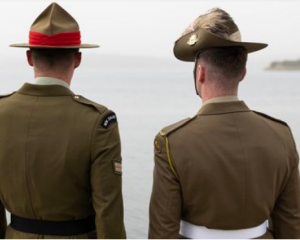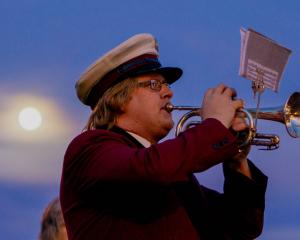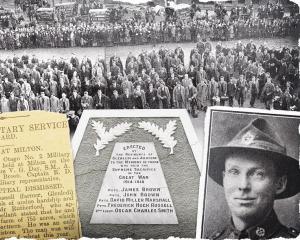Fittingly, it is raining on Flanders fields, just as it was 92 years ago when these farmlands became a major killing field of the Western Front in World War 1.
That autumn of 1917 was the wettest for 70 years and the flat Belgian landscape was churned by 4 million German and Allied shells into a sloppy porridge that swallowed anything and everything.
All that was left were matchstick trees.
Massive opposing armies were locked together here in a landscape of unbelievable desolation.
The battle lines barely moved for more than two years.
One can't visit Flanders without being deeply moved by the tragedy.
The statistics are horrendous.
In four years of fighting in this cramped corner of the Western Front, a million men on both sides were killed or wounded or went missing.
The battle of Passchendaele in the summer and autumn of 1917 alone cost half a million casualties.
In 100 days of heavy fighting between July and November, the Allies made a gain of only 8km.
Thirty-five men fell for every square yard taken.
The dead comprised mostly British, Australian, Canadian, New Zealand and South African troops.
And the battle was all for nothing.
Today, the scene around Ypres and Passchendaele is very different.
The desolate battlefield landscape has long since gone.
Nothing we see now is older than 90 years - no farm building, no fence, no tree.
It is hauntingly peaceful.
Ordinary farmland, in fact.
We look at fields of head-high corn and lush green pastures where cows graze contentedly.
Beneath these pastures still lie tens of thousands - even hundreds of thousands, it has been estimated - of young men cut down in the bloodiest of bloody wars and most of whose bodies have never been recovered.
Even today some remains are still being found.
For every life lost there is a story.
Author Rudyard Kipling lost his only son, John, on his first day in battle here.
Kipling spent three years looking for his son's body, which was found only after Rudyard's death.
While Gallipoli has become a major shrine to the memory of the Anzacs and a place of pilgrimage, the Western Front claimed more - many more - Australian and New Zealand lives.
Ypres has become particularly associated with Commonwealth forces who were here continuously from October 1914 to the end of the war in 1918.
The area was thickly sown then with hundreds of soldiers' cemeteries, many more than the 150 remaining today.
Tyne Cot, with 12,000 graves, is the world's largest Commonwealth war cemetery and is splendidly maintained by the Commonwealth War Graves Commission.
The names of 34,957 soldiers missing in action are also listed at Tyne Cot.
Originally, Tyne Cot was a bunker on the German line.
On October 4, 1917, Australian soldiers captured the position and used it as an advanced dressing station.
Soldiers who died of their injuries were buried on the site.
Several German blockhouses remain as a grim reminder.
Nearby, too, is what's left of two German machine-gun positions.
The rear wall of the cemetery bears the names of 35,000 British, Australian and New Zealand servicemen who died there after August 16, 1917.
A visitor centre at Tyne Cot and the Memorial Museum Passchendaele 1917 opened in 2007, the latter attracting 300,000 visitors in its first year.
The museum exhibits memorabilia - letters from solders, uniforms, badges, equipment.
The names and ages of the dead are broadcast in continuous slow and reverent readings.
For a closer look at the battlefield, you can walk a 3km historic walking route, The Road To Passchendaele.
Along with the remains of soldiers, every year 300 tonnes of munitions are recovered by farmers tilling their farms.
Local residents have become accustomed to putting out for collection their household rubbish on one side of their driveway and unexploded World War 1 munitions on the other side.
We see an example - a rusted shell.
It's an iron harvest among the harvest of corn.
The growing number of visitors, including more and more Australians and New Zealanders, is evidence of an increasing pilgrimage to Flanders.
Just days before our visit, a group of Australian schoolchildren had toured the battlefields.
The Menin Gate in Ypres is a memorial to British and Commonwealth officers and men missing in the Ypres salient (district).
It straddles one of the town's busiest roads and is a constant reminder of sacrifice.
It bears panel after panel of 54,896 names of those who died in the salient and have no known graves.
To stand beneath the great arch is very moving, especially any evening at 8pm.
Volunteers from the local fire brigade have played the Last Post here at that time every night since 1928 - except for four years during World War 2 .
Ypres, or "Wipers" as the Diggers called it, was once a great commercial centre, specialising in cloth.
The quiet market town was destroyed and rebuilt between 1922 and 1926 in a style faithful to the original.
It again suffered terribly in World War 2, falling to the Germans in just one day, and was occupied until being liberated on September 6, 1944.
A number of tour companies offer tours of the battlefields.
We chose Salient Tours, whose guide, Chris, is a former British army officer and student of the Great War.
We stop at Essex Farm Cemetery, which was part of the front line between April, 1915, and August, 1917.
Here is one of the few tangible reminders of the war - a concrete building used as a field dressing station.
Here, too, Canadian surgeon John McCrae wrote his classic poem In Flanders Fields, which has become the anthem of the Great War.
And further along our tour we pass a monument, a brooding Canadian soldier, at Vancouver Corner, where chlorine gas was first used to kill 2000 Canadians.
In the Ypres city centre is an In Flanders Fields Museum.
On the first floor of the restored Cloth Hall on Market Square, this is a must-see.
The visitor is plunged into surroundings of the Great War through documentary film, sight-and-sound exhibits, interactive and hands-on displays, and many contemporary documents.
We had arrived in Ypres on a fast, comfortable intercity train from Paris, via Lille, and finished the journey by local train.
It had taken less than four hours.












